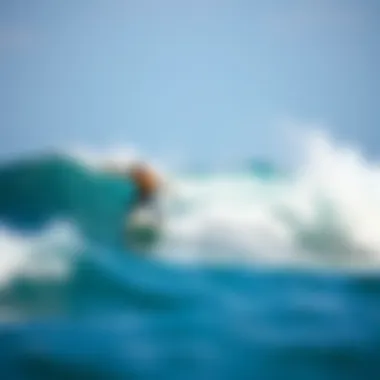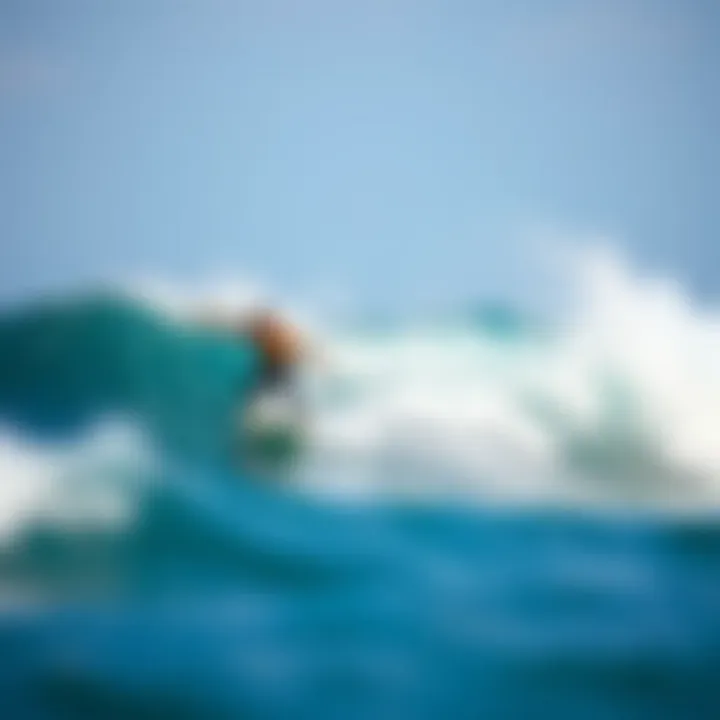Discovering the Unique World of Fun Shape Surfboards


Intro
Surfboards have evolved over the decades, becoming not just tools for riding waves but artistic statements that reflect the surfer's personality. Among the diverse range of surfboards available today, fun shape surfboards stand out due to their unique appeal and design. These boards, often characterized by their unconventional shapes and playful aesthetics, merge functionality with creativity in a way that attracts both novice and experienced surfers.
Whether you're just paddling into your first wave or cutting through the water with advanced maneuvers, understanding fun shape surfboards can enhance your surfing journey. This segment dives into the nuances, functionality, and cultural significance of these boards, offering insights into their vibrant designs and suitability for distinct surfing styles.
From materials to performance aspects, we'll explore how these surfboards cater to a wide variety of skill levels. We'll also take a peek into the broader context of surfing culture, examining how fun shape surfboards reflect both the spirit of creativity in surfboard design and the evolution of the surfing community.
Techniques and Tips
Essential Surfing Techniques for Beginners
For those just starting to ride the waves, mastering some fundamental techniques is key to building confidence and enjoying the sport. Here's what beginners should focus on:
- Paddle Properly: The first step in catching a wave is mastering your paddling technique. Keep your body centered and use your arms in a rhythmic motion.
- Position on the Board: Finding the right balance is essential. Lie in the middle of your board, where the buoyancy is best, to help you catch that wave.
- Pop Up Smoothly: When it's time to stand up, practice popping up in one smooth motion. Your feet should land shoulder-width apart for balance.
- Look Ahead: Don’t stare down at your feet; keep your gaze forward to maintain balance and control.
Advanced Maneuvers for Experienced Surfers
Once you’ve outgrown the basics, it’s time to refine your techniques and explore more advanced skills. These maneuvers will help improve your performance on fun shape surfboards:
- Carving Turns: Use your body weight and shifts in balance to carve beautiful turns on the wave face.
- Aerials: With enough speed, launching off the lip of a wave allows for exciting aerial tricks.
- Tube Riding: Catching and riding inside a breaking wave is about timing and positioning. Practice will allow you to feel the wave’s energy.
“A good surfer can catch a wave, but a great surfer knows how to dance with it.”
Gear and Equipment
Understanding the right gear and equipment can greatly enhance your surfing experience. Fun shape surfboards are versatile and come with various features that can aid in performance.
Choosing the Right Fun Shape Surfboard
- Width and Length: Wider boards offer better stability, making them ideal for beginners, while longer boards can provide better speed for advanced surfers.
- Nose Shape: A rounded nose can help in smooth entry onto waves, while a pointed nose may provide better cutting ability.
- Tail Design: Different tail shapes influence how a board rides on the wave. For instance, a swallow tail offers quick turns, while a square tail delivers more power.
Popular Brands*
Among the well-respected brands in the fun shape segment are:
- Firewire Surfboards
- Lost Surfboards
- Channel Islands
- JS Industries
Each brand brings its unique designs and technology to the table, appealing to various skill levels and preferences.
Must-Have Accessories for Every Surfer
- Leash: Always have a reliable leash attached to your board; it prevents your board from drifting away.
- Wax: Proper wax ensures you will have a good grip on your board for better control.
- Ding Repair Kits: For any nicks and dings, keeping a repair kit handy saves you hassle after a tumble.
For more detailed resources on fun shape surfboards and surfing gear, check out Wikipedia on Surfboards or visit forums like Reddit's Surfing Community.
This guide serves as a stepping stone for anyone looking to deepen their understanding of fun shape surfboards. By grasping the techniques and gear associated with these boards, surfers of all skill levels can enrich their experience and fully embrace the ocean's waves.
Foreword to Fun Shape Surfboards
Fun shape surfboards present not just a means of riding waves, but a canvas for creativity and expression in the surfing world. These boards are celebrated for their distinctive designs and functionality, catering to a wide variety of surfing styles. They blend performance with personality, offering surfers more than just a tool but an experience tailored uniquely to their individual tastes and abilities.
The importance of understanding fun shape surfboards lies in appreciating how they embody the intersection of art and sport. Surfers, whether beginners or seasoned pros, find that every curve, contour, and dimension on a fun shape board impacts their ride. This exploration coincides with the broader narrative about surfing culture, where these boards symbolize innovation and freedom.
Defining Fun Shape Surfboards


When one thinks about surfboards, images of sleek, longboards or high-performance shortboards might spring to mind. However, fun shape surfboards deviate from conventional styles. They often feature non-standard silhouettes, allowing for increased versatility in performance. A typical fun shape board could display a wider nose, a chubbier outline, or a thicker profile compared to traditional boards, all contributing to a more forgiving ride.
These boards encourage creativity both in and out of water. Riders can navigate waves with a sense of playfulness, thanks to designs that facilitate easy mixing of tricks and maneuvers. For instance, a fun shape surfboard with a round tail can enhance stability, providing a solid platform for beginners experimenting with turns and transitions. Meanwhile, more advanced surfers may appreciate the potential for aerial moves and unique carves on an unconventional shape.
The Evolution of Surfboard Designs
Surfboards have come a long way from their rudimentary wooden counterparts. The evolution from heavy, cumbersome boards to the lightweight, finely-tuned shapes we see today illustrates a story of innovation spurred by necessity and creativity.
The introduction of foam and fiberglass in the mid-20th century marked a pivotal point. These materials significantly reduced weight while enhancing durability, allowing boards to be shaped into more dynamic forms. Subsequently, different surf styles emerged, emphasizing the need for boards that pushed beyond established norms—hence the fun shape surfboard was born.
Over the years, shapers have experimented with various outlines, tail types, and rocker profiles. This ongoing experimentation reflects what surfers desire: speed, maneuverability, and ultimately, fun. Shapers like Chris Christenson and Matt Biolos have become known for cranking out boards that not just reflect surfing trends, but also pioneering new ones.
Ultimately, this evolution challenges surfers to rethink their expectations and expand their horizons when choosing a board. A fun shape surfboard could very well serve as your introduction to a whole new realm of water sport enjoyment.
Characteristics of Fun Shape Surfboards
The distinct features of fun shape surfboards underscore their unique appeal within the swimming world. These boards are not just about flashy designs; their characteristics play a crucial role in their performance and usability, meeting the diverse needs of surfers across skill levels. In this section, we will delve deeper into three major aspects of fun shape surfboards that contribute to their popularity and functionality: shape and size variations, tail designs, and nose shapes.
Shape and Size Variations
The shape and size of a fun shape surfboard can greatly influence how it rides the waves. Unlike traditional surfboards, which typically stick to a conventional outline, fun shape boards embrace a variety of contours that cater to different surfing styles and conditions.
- Varied profiles: These boards might feature wider noses or more rounded tails. Wider noses can help with paddling, while rounded tails can improve turn responsiveness.
- Size matters: Fun shape boards come in lengths and widths that can accommodate various surfer preferences, from shorter boards that are suited for tricks to longer ones that provide stability.
- Experimenting with shapes: Many surfers find joy in testing different shapes, making the fun shape an excellent choice for experimentation.
For instance, a board with a fun, exaggerated outline could provide an exhilarating ride on smaller, quicker waves, perfect for a surfer looking to add flair to their performance. Such diversity in shape and size fosters creativity, keeping the excitement alive in each surf session.
Tail Designs and Their Impact
A surfboard's tail design functions as a critical component impacting how it interacts with the water, significantly affecting maneuverability, speed, and control. Fun shape surfboards often sport various tail styles, each catering to different surfing techniques.
- Swallowtail: This tail design is best suited for sharp turns and quick maneuvers, allowing surfers to carve fluidly through waves.
- Pin tail: On the other hand, the pin tail is excellent for stability at high speeds, making it ideal for larger waves.
"Choosing the right tail design on a fun shape board can enhance performance, letting a surfer express their unique style on the water."
- Square and round tails: These designs provide their own advantages: square tails offer better drive, while round tails excel at smooth transitions.
Understanding the impact of tail designs enables surfers to select boards that align with their personal styles and the type of waves they usually ride. This customizability adds to the allure of fun shape surfboards, highlighting their functional creativity.
Nose Shapes and Performance Enhancements
The nose shape of a fun shape surfboard is more than a design element; it is pivotal in influencing how the board behaves in the water. Different nose shapes cater to various surfing styles, enhancing performance based on the surfer's skill level and the type of waves.
- Traditional nose: Often seen on many boards, it provides stability and a classic feel, making it comfortable for beginners who are still finding their footing.
- Wide nose: This shape offers extra volume, aiding with paddling and wave catching, especially in smaller surf.
- Pointed nose: Suited for high performance, it allows for quick drops and tight turns in more challenging wave conditions.
Surfers choosing the right nose shape can maximize their potential on the water, improving not only their performance but also their enjoyment of the sport. The interplay between various nose shapes and surfboard performance underlines the innovation that fun shape surfboards bring to the table.
Materials Used in Fun Shape Surfboards
Understanding the materials that go into fun shape surfboards is key to appreciating their performance and uniqueness. The choice of materials not only affects the board's durability but also its buoyancy, weight, and responsiveness in the water. The interplay between traditional and innovative materials showcases how the surfing industry is evolving to meet the demands of surfers while also considering environmental impacts.


Traditional Materials: Fiberglass and Foam
When it comes to classic surfboard construction, fiberglass and foam have long been in the spotlight. Fiberglass is highly valued for its strength and lightweight characteristics, making it ideal for reinforcing surfboards. This composite material is made up of fine glass strands woven together and then treated with resin. It offers excellent impact resistance, which is crucial in the rigorous environment of ocean surfing.
Foam, on the other hand, serves as the core material for many surfboards, including fun shapes. Expanded polystyrene (EPS) foam is particularly popular, providing a solid foundation that is both buoyant and lightweight. Together, fiberglass and foam create a synergy, enabling boards to float efficiently while allowing for fluid movements during paddling and riding waves.
Here are a few key points regarding these traditional materials:
- Durability: Fiberglass provides a tough outer shell that can withstand a good deal of pressure and impact.
- Weight: Foam keeps the board light, allowing for easier maneuverability.
- Cost-Effective: Boards made from these materials are often more affordable, making them accessible to a wider range of surfers.
Although traditional materials hold their ground, advancements in surfboard technology have led to the emergence of new materials that prioritize sustainability and performance.
Innovative Materials: Sustainability and Performance
As surfing continues to grow, there has been a noticeable shift towards using sustainable materials without compromising on performance. Today, manufacturers are exploring an array of alternatives that minimize ecological impact while enhancing the surfing experience. For instance, some boards incorporate bio-resins, which are derived from renewable sources as opposed to petroleum-based products.
Biodegradable foam is also making waves in the industry. This new-age material offers the buoyancy surfers crave while ensuring that the environmental footprint is reduced. As surfers become more ecologically aware, their demand for eco-friendly surfboards has led many brands to innovate.
Here are some emerging trends associated with these materials:
- Recycled Materials: Some companies utilize recycled materials to create boards, significantly reducing waste.
- Natural Fibers: Utilizing organic materials like hemp or flax can enhance the board's performance while being less harmful to the environment.
- Lightweight Composites: Innovations in composites can lead to increased strength without the heft, resulting in superior flexibility and responsiveness on waves.
"Every time we paddle out, we should consider the materials we're riding on and their impact on our planet." - Surfing Community Advocate
Suitability for Various Skill Levels
The diverse landscape of surfing necessitates boards that cater to different levels of expertise. Fun shape surfboards, with their unique designs and characteristics, have become increasingly popular among surfers of all abilities. Understanding the relevance of suitability for various skill levels enhances one’s enjoyment, safety, and overall performance on the waves.
Beginner-Friendly Designs
When it comes to new surfers, stability and ease of use are paramount. Fun shape surfboards for beginners often feature wider outlines and fuller noses. This stability allows novices to feel confident, making it less likely they’ll wipe out while trying to catch their first wave. The buoyancy inherent in these boards not only aids in flotation but also in paddling.
A few key features tailored for beginners include:
- Wider Width: Provides a larger surface area for balance.
- Softer Rails: Makes it easier to turn without losing control.
- Larger Volume: Assists in catching waves quickly.
Beginners might gravitate towards boards like the Walden Soft Top or Catch Surf Odysea, as they provide a forgiving introduction to the sport while ensuring that learning remains a fun and fruitful venture.
Advanced Techniques for Experienced Surfers
For seasoned surfers, the playful nature of fun shape boards can be an exhilarating way to hone skills. Advanced surfers often experiment with various shapes and technologies to add flair to their riding. These boards might utilize innovative fin setups or varying tail shapes, allowing for tighter turns and agile maneuvers.
Experienced surfers often look for:
- Performance Tail Designs: Enhances speed and responsiveness.
- Narrower Outline: Allows for advanced turning and control.
- Customizable Fins: Lets surfers adapt their ride to various conditions.
The beauty of fun shape surfboards lies in their capacity to evolve alongside a surfer's skills. While they deliver the playful spirit, boards such as the Lost Puddle Jumper or Firewire Seaside push the boundaries of what these shapes can offer, inviting surfers to explore new possibilities in their technique and creativity.
"The right surfboard is more than just a piece of equipment; it’s an extension of who you are as a surfer."
With an understanding of how these boards fit within both beginner and advanced skill levels, surfers can better appreciate their role in the sport. The versatility and uniqueness of fun shape surfboards present an opportunity for all surfers, whether launching their first ride or landing advanced tricks, to truly enjoy their time on the water.
Cultural Significance in Surfing


The world of surfing has always been more than just riding waves. Fun shape surfboards, in particular, encapsulate a vibrant culture that melds creativity, self-expression, and community. These boards are not only tools for recreation; they are symbols of a lifestyle that cherishes individuality and freedom. Their unique shapes and designs reflect the surfers' personalities and experiences, embedding them into the very fabric of surf culture.
The Role of Fun Shape Boards in Surf Culture
Fun shape surfboards have carved their niche in the surfing community, representing a shift from traditional designs toward more playful, varied forms. The creative freedom they offer encourages surfers to push boundaries, not just in performance but also in aesthetic. These boards often embrace bold colors and unconventional shapes, making their riders stand out both on and off the water.
- Expression of Self: For many surfers, their choice of board articulates aspects of their personality. A vividly painted fish tail might suggest a carefree spirit, while a sleek, symmetry-driven design could speak to a more serious approach to surfing.
- Community Engagement: Fun shape surfboards have sparked a sense of camaraderie among surfers. Events centered around these boards often bring together enthusiasts from all over, promoting a deeper sense of belonging and shared passion within the surf community.
- Cultural Preservation: These boards also play a role in preserving the history and evolution of surf culture. As surfers experiment with new shapes and styles, they keep alive the spirit of innovation that has been crucial to the sport's growth.
Iconic Moments and Famous Surfers
Throughout history, certain surfers have cemented their legacy not just through their incredible skills but also by embracing the fun shape movement. Their stories are interwoven with unforgettable moments that have defined the landscape of surfing.
"Surfers are a bit like artists; they express themselves through their board designs and styles, contributing to a broader narrative that describes our culture."
- Tom Curren: Known for his style and grace, Curren was a pioneer who embraced various surfboard shapes. His influence has resonated with generations, merging traditional surfing with innovative approaches.
- Lisa Anderson: A trailblazer for women in surfing, Anderson’s skills on a fun shape board challenged norms and inspired countless female surfers. Her iconic performances helped elevate the profile of women’s surfing.
- The 1970s and 80s Revolution: This was a decade marked by the fun shape era, where surfers started to experiment more boldly with shapes, leading to classic moments captured by films and photographs that still influence today’s designs. Riders like Gerry Lopez became synonymous with this evolution, showcasing how fun shapes could transform performance and style.
The cultural significance of fun shape surfboards lies in their ability to merge history, personal expression, and camaraderie within the surfing community. They remain an enduring symbol of the spirit of surfing—dynamic, creative, and ever-evolving, shaping not just the waves we ride but the culture we cherish.
For more insights into surfing culture and its evolution, check out resources on Wikipedia and Britannica. Feel free to delve into discussions on platforms like Reddit to see what the community is buzzing about.
Emerging Trends in Fun Shape Surfboards
The surfboard industry, much like the ocean itself, is constantly shifting and evolving. Fun shape surfboards, with their playful designs and unique characteristics, are right at the forefront of this transformation. Exploring the emerging trends helps enthusiasts understand not only the current state of the art but also where it might head in the future. The landscape of surfboarding is exciting, and these new developments promote an inclusive community, encouraging both creativity and innovation among surfers.
Customization and Personalization
Many surfers long for a board that is as unique as they are, and customization is rapidly becoming one of the most prominent trends in fun shape surfboards. Surfboard makers are now offering modular designs that allow for tailor-made adjustments according to a rider’s taste and skill level. This tailored approach goes beyond just color schemes and graphics. Surfboards can have adjustable fins, allowing surfers to adapt their board’s performance based on the conditions of the waves on any given day.
Moreover, some companies are utilizing 3D printing technology to produce boards made to specific dimensions and designs. This not only leads to a more personal touch but also allows a greater experimentation in the construction processes. The beauty in customization is that no two boards need to be exactly the same, creating a canvas for self-expression on the waves.
One key benefit of such customization is that it fosters a deeper connection between the surfer and their board. When a board is tailored to fit not just physical needs but also style preferences, it enhances the overall surfing experience. Surfers can truly make their mark on the ocean, riding on a board that reflects their personality.
Integration of Technology in Surfboard Design
As technology advances, so too does the design of surfboards. Contemporary fun shape surfboards often incorporate innovative materials and smart technology that promote better performance and safety on the waves. For instance, manufacturers are now integrating lightweight composites that not only provide strength but also enhance buoyancy.
Furthermore, the embedded tech does not stop there. Some surfboards are now fitted with sensors that can track speed, wave height, and even surfing techniques. These data points can then be synced to an app, giving surfers immediate feedback on their performance. With the ability to analyze their rides, surfers can refine their skills dynamically, taking their surfing to another level.
"The integration of technology helps bridge the gap between tradition and modernity in surfing, ensuring that folk who ride these boards are both safe and informed on the waves."
It's noteworthy to mention that sustainability is also a driving force behind these technological advancements. Emerging eco-friendly materials are designed to reduce the carbon footprint of surfboards, challenging manufacturers to rethink their production methods. This is a great leap toward making the sport more environmentally responsible as the surfing community becomes increasingly aware of the wider ecological impact.
Ending
In the dynamic realm of surfing, fun shape surfboards have carved out a crucial niche. Their importance lies not only in their unique designs but also in the way they encapsulate the spirit of creativity and experimentation in the surfing community. The interaction between shape and performance is a key consideration for surfers of all abilities; these boards invite riders to push boundaries while celebrating the joy of riding waves.
Embracing the Diversity of Surfboard Shapes
Diversity in surfboard shapes goes beyond mere aesthetics. It serves multiple functions, from catering to different wave types to enhancing an individual surfer's style. Fun shape surfboards showcase a variety of forms that emphasize personal preference and adaptability in various conditions. Here are some noteworthy aspects of their diversity:
- Shape Variations: Fun shapes are notably creative. They can range from understated designs to outlandish variations that may feature exaggerated rocker lines or whimsical outlines. Each shape serves a purpose, addressing the unique needs of surfers.
- Skill Adaptation: As we discussed, different shapes cater to different skill levels. A board with a wider nose can offer more stability for beginners, while an experienced surfer might opt for a more refined shape that allows for rapid turns and agility.
- Cultural Exploration: Fun shape surfboards often bear the influence of various surfing cultures, telling a story about the locale they hail from. Whether it is the vibrant colors from Hawaiian surfboards or the more minimalist Scandinavian designs, each artifact reflects cultural identity and heritage.
"The beauty of surfboard shaping lies not just in function but in the soul each board carries, resonating with its creator's intent."
By embracing this diversity, surfers can explore an endless range of possibilities. This leads to a richer experience, both in terms of performance and personal expression. As the surfing landscape continues to evolve, staying open to various shapes and styles remains essential for any surfer eager to enhance their skills and enjoyment on the water.



